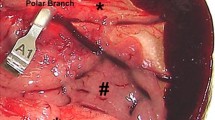Summary
In acute pancreatitis, damage to the liver is an important aspect of multiorgan failure. In 28 dogs (20 with bile-trypsin induced acute experimental pancreatitis (AEP)), ‘total’ and ‘free’ activity of lysosomal hydrolases: β-glucuronidase, cathepsins and acid phosphatase in mitochondrial and lysosomal subfraction of the liver were determined 12 h or 24 h after the induction of AEP. The respiratory control ratio with sodium succinate as a substrate, using Clarck's electrode and uncoupler-dependent ATP-ase activity in mitochondrial subfraction, was assayed. Groups of dogs were treated or pretreated with prostacyclin (PGI2), 20 ng·kg−1·min−1 1.v. for 12 or 13 h. The relative free activity of hydrolases was significantly elevated in untreated AEP after 12 h and was partially normalized in AEP after 24 h or after 12 h followed by treatment and pretreatment with PGI2. Respiratory control ratio was twice lower than normal in AEP after 12 h and partially normalized after 24 h post PGI2 treatment. The relative free activity of lysosomal hydrolases was highly negatively correlated with respiratory control ratio. It was concluded, that during AEP in dogs the function of liver mitochondria and lysosomal stability are impaired. The significant correlation found between the mitochondrial and lysosomal lesions points to lysosomal-mitochondrial interactions in liver damage in AEP. Prostacyclin in the investigated dose partially prevents the mitochondrial and lysosomal lesions in liver in this disease.
Similar content being viewed by others
References
Fisher ER, McCloy D. Hepatic lesions of acute hemorrhagic pancreatitis. Surgery 1955;37:213–219.
Kitamura O, Ozawa K, Honjo J. Alterations of liver metabolism associated with experimental acute pancreatitis. Am J Surg 1973;126:379–382.
Rao KN, Zuretti MP, Baccino FM, Lombardi B. Acute hemorrhagic pancreatitis necrosis in mice. The activity of lysosomal enzymes in the pancreas and the liver. Am J Path 1980;98:45–59.
Gabryelewicz A, Popow J, Musiatowicz B, Paprocki M. Behavior of nonspecific phosphatases in the liver during acute experimental pancreatitis in dogs. Acta Physiol Polon 1968;19:319–325.
Hirai F, Aoyama H, Ohtoshi M, Kawashima S, Ozawa K, Tobe T. Significance of mitochondrial enhancement in hepatic energy metabolism in relation to alterations in hemodynamics in septic pigs with severe peritonitis. Eur Surg Res 1984;16:148–155.
Mela L, Miller LD, Bacalzo Jr LV, Olofsson K, White RR. Role of intracellular variations of lysosomal enzyme activity and oxygen tension in mitochondrial impairment in endotoxemia and hemorrhage in the rat. Ann Surg 1973;178:727–735.
Standfield NJ, Kakkar VV. Prostaglandins and acute pancreatitis: experimental and clinical studies. Brit J Surg 1983;70:573–576.
Araki H, Lefer AN. Cytoprotective actions of prostacyclin during hypoxia in the isolated perfused cat liver. Am J Physiol 1980;238:H176-H181.
Fletcher JR, Ramwell PW. The effects of prostacyclin (PGI2) on endotoxin shock and endotoxin-induced platelet aggregation in dogs. Circ Shock 1980;7:294–308.
Lefer AM, Araki H. Analysis of potential beneficial actions prostaglandins in traumatic shock. In: Molecular and cellular aspects of shock and trauma. New York: AR Liss Inc, 1983.
Gabryelewicz A, Dlugosz J, Brozozowski J, Musiatowicz B, Sidun-Kuryłowicz Z, Wereszczyńska U, Triebling A. Prostacyclin: effect on pancreatic lysosomes in acute experimental pancreatitis in dogs. M Sinai J Med 1983;50:218–224.
Triebling AT, Dlugosz J, Brzozowski J, Andrzejewska A, Wereszyńska U, Gabryelewicz A. The renal lysosomes in acute experimental pancreatitis in dogs treated with prostacyclin (PGI2). Path Res Pract 1984;178:280–288.
Andrzejewska A, Dlugosz J, Kurasz S. Ultrastructure of liver in acute experimental pancreatitis in dogs treated with prostacyclin. Exp Pathol 1987;31:25–31.
Szczeklik A, Gryglewski RJ. Actions of prostacyclin in man. In: Vane JR, Bergström S. eds. Prostacyclin, Ch. 36, New York: Raven Press, 1979;393–407.
Elliott DW, Williams RD, Zollinger RM. Alteration in pancreatic resistance to bile in the pathogenesis of acute pancreatitis. Ann Surg 1957;146:669–682.
Gianetto R, de Duve C. Tissue fraction studies. 4. Comparative study of the binding of acid phosphatase, β-glucuronidase and cathepsin by rat liver particles. Biochem J 155;59:433–438.
Ruth RC, Weglicki WB. Mechanisms of loss of latency of lysosomal enzymes. Biochem J 1980;186:234–256.
Estabrook RW. Mitochondrial respiratory control and the polarographic measurement of ADP: O ratios. In: Estabrook RW, Pullman ME. eds. Methods in enzymology. New York: Academic Press 1967;41–47.
Armitage P, Statistical Methods in Medical Research. Oxford, London, Edinburg, Melbourne: Blackwell Scientific Publications. 1971.
Coticchia JM, Lessler MA, Ellison EC, Carey LC. Mitochondrial dysfunction induced by pancreatitis associated ascitic fluid. Proc Soc Exp Biol Med 1983;172:412–418.
Ahlberg J, Marzella L, Glaumann H. Uptake and degradation of proteins by isolated rat liver lysosomes. Suggestion of a microautophagic pathway of proteolysis. Lab Invest 1982;47:523–532.
Erickson JL, Brunk VT. Alterations in lysosomal membranes as related to disease processes. In: Trump BF, Arstilla AV, eds. Pathobiology of cell membranes, Vol. I, Ch. VI, New York: Academic Press, 1975;217–253.
Trump BF, Mergner WJ. Cell injury. In: Zweifach BW, Grant L, McCluzkey ET. eds. The inflammatory process, Vol. I, Ch. 3. New York, San Francisco, London: Academic Press, 1974;115–257.
Flynn JT. Effect of 2,4-dinitrophenol on the rate of hepatic prostaglandin production. Adv Shock Res 1981;5:149–162.
Dlugosz J, Musiatowicz B, Kurłowicz-Sidun B, Wereszczyńska U. The enzymatic studies of the liver in acute experimental pancreatitis in dogs treated with prostacyclin (PGI2). Pathol Res Pract 1987;182:80–86.
Author information
Authors and Affiliations
Rights and permissions
About this article
Cite this article
Długosz, J., Pawlicka, E. & Gabryelewicz, A. Lysosomal-mitochondrial interrelationships in damage to the liver in acute experimental pancreatitis in dogs. Treatment with prostacyclin (PGI2). Int J Pancreatol 3, 343–356 (1988). https://doi.org/10.1007/BF02788468
Received:
Accepted:
Issue Date:
DOI: https://doi.org/10.1007/BF02788468



